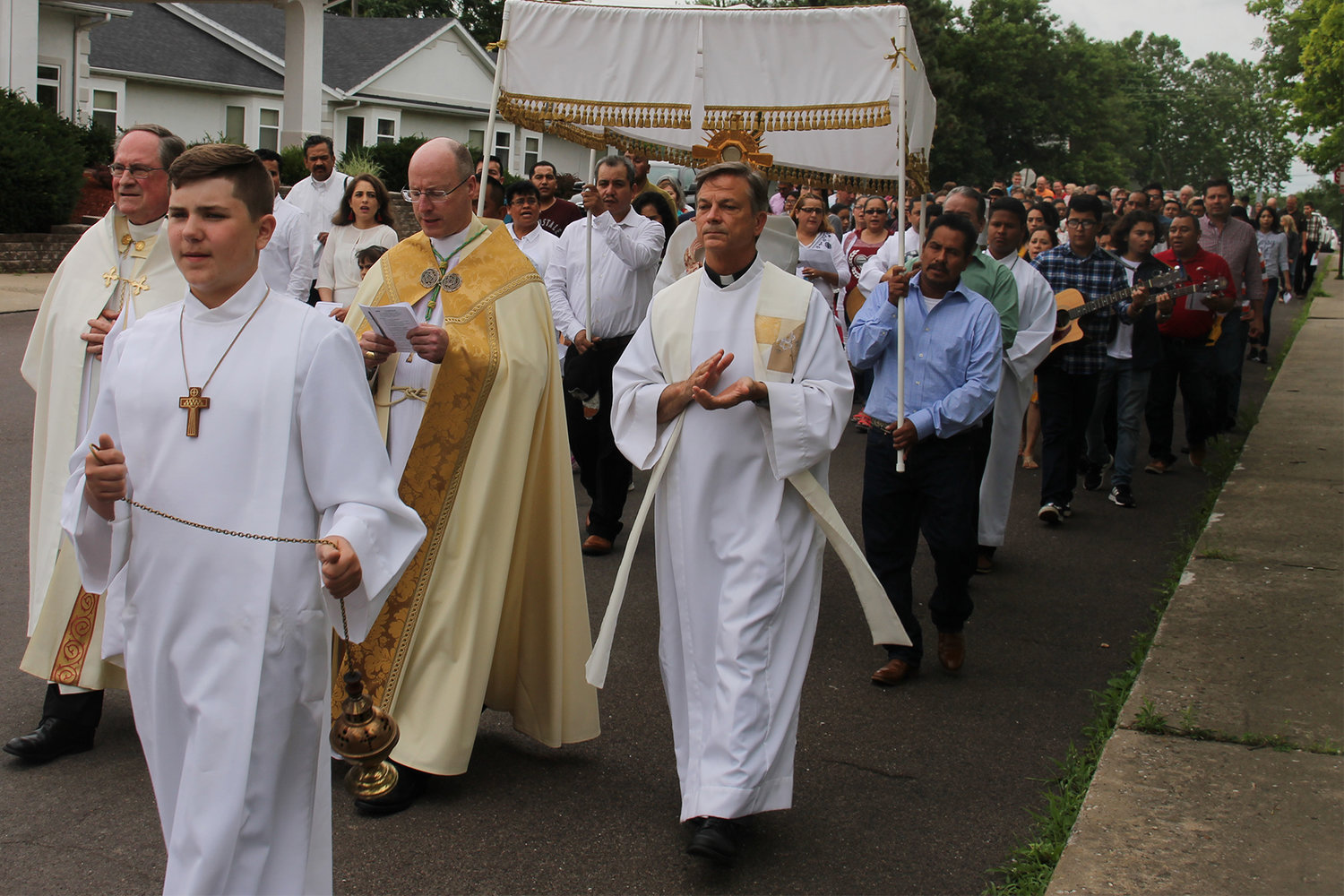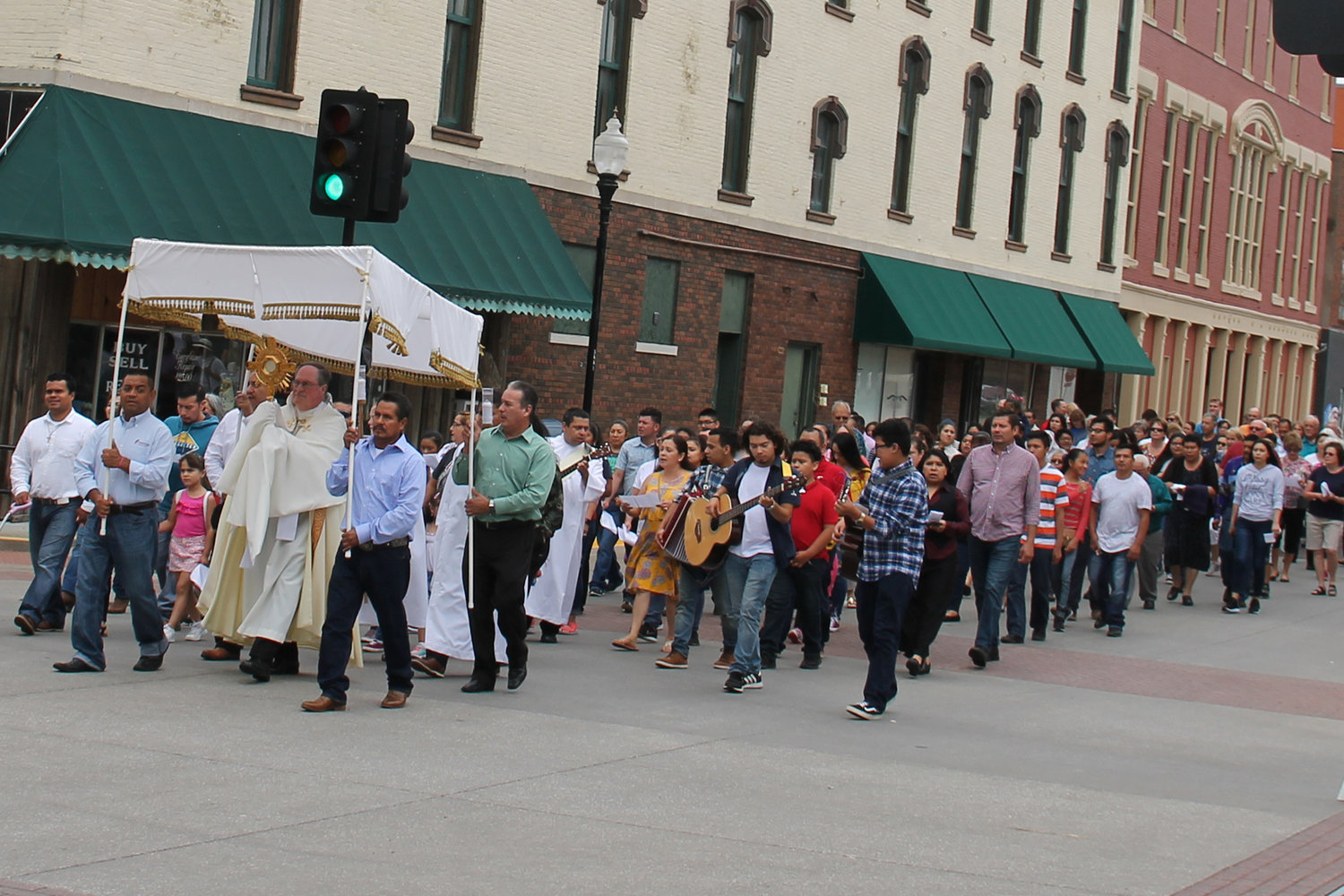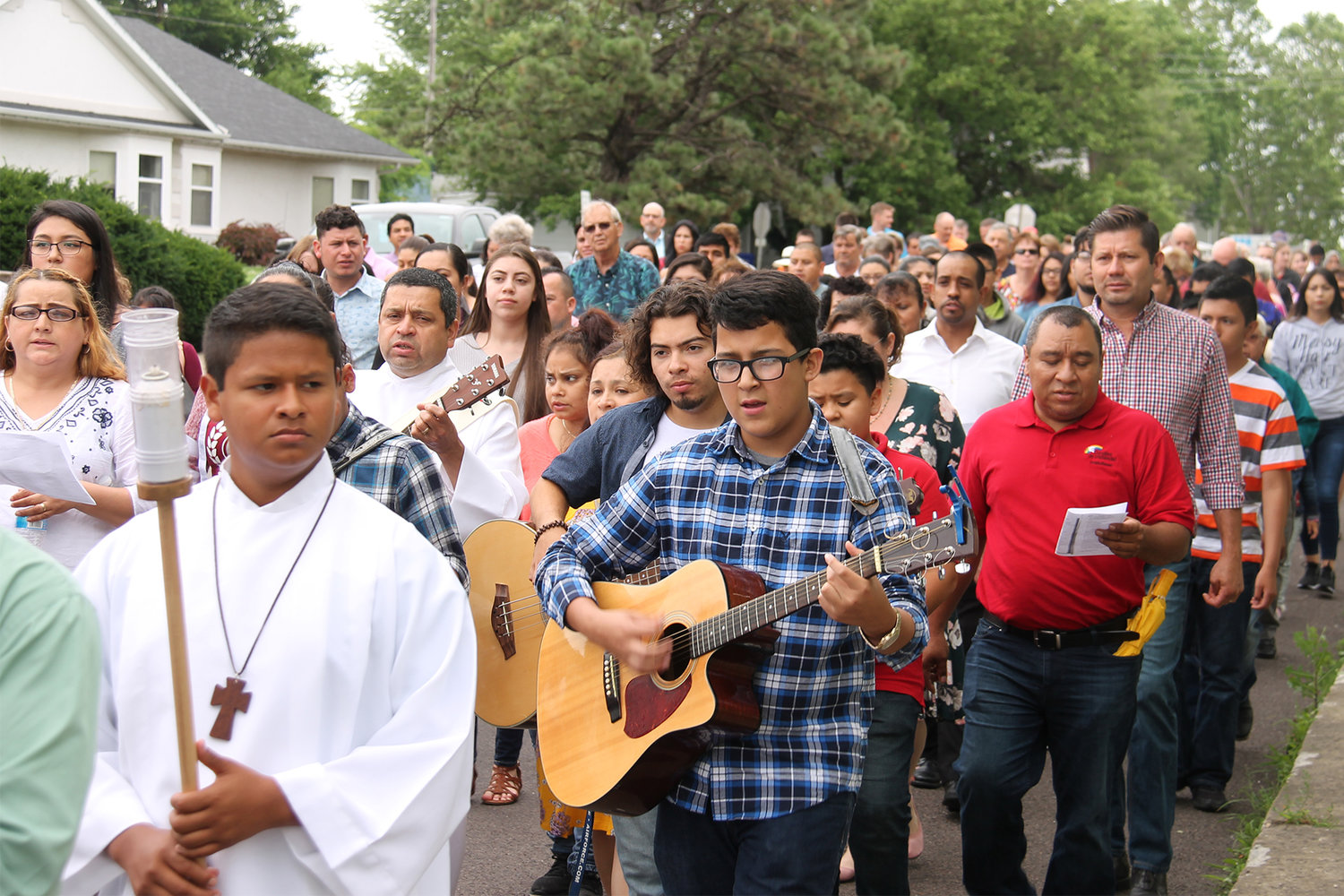Bishop thanks Missionaries of the Precious Blood for 137 years of service in Pettis County and beyond
Responsibility for Sedalia parishes, Bahner mission turned over to diocesan priests — Fr. Miller to retire — Fathers Corel and Veit to lead new parish together — Working to become one parish with three worship sites — School to continue as Sacred Heart

CLICK HERE to see two galleries of photos from this event.
There is wonder-working power in the Precious Blood of the Lamb.
Witness the 137-year, symbiotic relationship between the Catholics of Pettis County and the Missionary Society of the Precious Blood.
Priests of the society ministered for nearly 14 decades at Sacred Heart parish in Sedalia.
They also served since the early 1980s at neighboring St. Patrick parish and for many years at the St. John the Evangelist mission in nearby Bahner.
At various times, Precious Blood priests also served in Boonville, California, Cedron, Clifton City, Cole Camp, Fayette, Jefferson City, Marshall, Pilot Grove, St. Elizabeth, Sweet Springs, Warsaw and other communities in this diocese.
Bishop Joseph M. Marling C.PP.S. (+1956-69), founding bishop of this diocese, was a Missionary of the Precious Blood, having served two terms as provincial leader of the society’s U.S. Province before his elevation to the episcopacy in 1947.
All the while, the Catholics of this area, especially in Pettis County, helped complete the priestly formation of newly ordained Precious Blood priests who were sent to minister to them.
Precious Blood Father Mark Miller, who turns 75 this year, is retiring from parish administration, after serving for eight years as pastor of the Sedalia parishes and Bahner mission.
In turn, the Missionaries of the Precious Blood are turning the ministerial responsibility for the Sedalia and Bahner congregations over to priests of the Jefferson City diocese.
This comes about as the Precious Blood society and its leadership continue discerning their roles as missionaries.
“Namely, we go where we believe our charism is most needed,” said Fr. Miller.
That often means handing ministries on to others as new avenues of ministry open up that are more in keeping with the society’s spirituality, he said.
Bishop W. Shawn McKnight appointed Father Joseph S. Corel and Father David Veit to serve the congregations as pastors “in solidum.”
In keeping with Canon 517 of the Revised Code of Canon Law, they will carry out the responsibilities of pastor together.
They arrived in Sedalia on June 30.
Fr. Miller is joining them as a pastor in solidum until Aug. 5, to help ensure a smooth transition.
All of this is taking place as the Sedalia parishes prepare to become one parish with three worship sites, taking the name of what was the area’s first Catholic parish — St. Vincent de Paul.
Their goal is to bring about more effective collaboration and grow in strength and unity in living and proclaiming the Gospel under the inspiration of the Holy Spirit.
Sacred Heart School, the only Catholic school in this diocese to offer pre-kindergarten through high school instruction, will keep its name and remain a vital part of the new parish’s mission.
Bringing it all together
Bishop McKnight; Precious Blood Father Garry Richmeier, provincial leader of the Missionary Society of the Precious Blood’s Kansas City Province; and priests and sisters who have served in and around Pettis County joined several hundred parishioners for a farewell service and celebration on June 23.
It was the Solemnity of the Most Precious Body and Blood of Christ.
Also participating were Fr. Corel, one of the new pastors in solidum; and Father Brendan Griffey, who has been serving as senior associate pastor in Sedalia and Bahner for two years.
Fr. Richmeier preached a homily at the beginning of the service in St. Patrick Church, followed by an outdoor procession of the Most Blessed Sacrament, concluding with a homily by Bishop McKnight and Benediction in Sacred Heart Church.
Fr. Richmeier noted that the Mass begins with seemingly simple ingredients — bread and wine. But they are actually products of a web of processes and ingredients, including soil, sunlight, air and rain.
“Without any one of those ingredients, there would be no wheat, there would be no grapes, there would be no bread and no wine,” he said.
He drew a parallel to God’s plan for salvation.
“We are all charged as followers of Jesus to grow the Reign of God,” said Fr. Richmeier. “To do that, we need to combine all of the ingredients. And that is all of us, each one of us, with our own gifts, our own talents, our own abilities, even with our own faults.
“We’re called to be part of that process, of that Reign of God that grows into something greater than any one of us is,” he said.
God’s people must work to overcome anything that divides them in order to become one, he said.
“That’s one of the charisms of our community, the Society of the Precious Blood — reconciliation, bringing people who are at odds together, so we can be one, and be the Reign of God,” he stated.
Jesus prayed for unity among His followers and constantly worked to heal divisions.
“That’s what we aspire to,” said Fr. Richmeier. “And here in this area, you have a unique opportunity to bring all of the elements together and create something new.”
It will be a challenge, but an exciting one, he said.
Hearts filled with gratitude
Fr. Griffey placed the Most Blessed Sacrament in a gilded monstrance, blessing people with Christ Fully Present before kneeling in adoration.
He then led the bishop, the priests and the people out of the church in procession, carrying the Most Blessed Sacrament under a canopy.
In Spanish, the people sang songs of praise and worship while processing westward through downtown Sedalia.
Fr. Griffey handed the Blessed Sacrament over to Fr. Miller as the procession reached Ohio Avenue, which for many years was the geographic boundary between St. Patrick and Sacred Heart parishes.
People praying inside Sacred Heart Church were chanting “Of the Glorious Body Telling” (“Pange Lingua Gloriosi”) as Fr. Miller led the people down the main aisle.
Again, the people listened to Scripture and silently adored Christ.
Bishop McKnight spoke, warning the people against taking the Body of Christ for granted.
“To be a Eucharistic people, we are called to be a people of gratitude,” he said.
“One could look at all the changes that have occurred in the history of the parishes of Pettis County, and complain that things are no longer the way they were,” he stated. “Or, we could follow the Eucharistic spirituality of our Lord and give thanks in all things, treasuring and savoring the abundant gifts God pours out on us every day.”
The bishop offered thanks to God for all that the Missionaries and the Sisters of the Precious Blood have meant to this diocese.
“Over a span of many years, they have nurtured our faith and led us in the practice of charity, peace and justice,” he said. “They became what we always expected to have, perhaps even feel entitled to have.”
He urged everyone to put their gratitude into action “by keeping the Eucharistic legacy alive in our community: in what we believe, in how we pray and in how we live as Catholics.”
“The greatest honor we could give the Precious Blood Fathers and Sisters,” he said, “is to imitate their big hearts as their devoted spiritual sons and daughters.”
Solid foundations
The celebration concluded with a reception adorned with memories and mementos in the Sacred Heart School gym.
Several former pastors and associate pastors greeted people, as did Precious Blood Sisters Eileen Schieber and Jeanette Buehler, representing the long line of Sisters of the Most Precious Blood of O’Fallon, Missouri, and Dayton, Ohio, who had served in the area.
Sr. Eileen served as director of religious education and Hispanic ministries at the parishes. Sisters from the Dayton congregation staffed Sacred Heart School from 1882 to 1973, as well as from 1938-54 at the former St. Joseph Mission School, which was for African American children.
Letters from priests, brothers and sisters who could not attend the celebration were posted in the reception hall, along with several historical mementos.
“Know of my prayer and continued love and gratitude for you as we bid farewell in our parish ministry among you,” wrote Precious Blood Father Bill Miller, who had served three assignments at Sacred Heart parish — as an associate pastor, pastor, and senior priest in service. “You remain an inspiration to me in my retirement.”
“I pray that God will continue to bless you, the Precious Blood community and all those who are part of the faith community,” wrote Sister Ellen Orf, a Sister of the Most Precious Blood of O’Fallon, who helped coordinate Hispanic ministry in Sedalia in the 1990s and early 2000s.
“As the care of the parish is entrusted to someone else, the foundations that have been built on over the years will hold firm,” wrote Precious Blood Sister Joyce Lehman, president of the Sisters of the Most Precious Blood of Dayton. “As the care of the parish is entrusted to someone else, the foundations that have been built on over the years will hold firm.”
Carrying Christ
The Congregation of the Missionaries of the Precious Blood was founded in present-day Italy to renew the clergy and laity through devotion to the Precious Blood that was offered up by Christ at the Last Supper and shed during His saving passion and death.
Precious Blood priests, brothers and seminarians arrived in the United States in 1843 to serve in parishes and schools.
The first of them in Pettis County arrived in Bahner in 1881 and began ministering to German-speaking Catholics in Sedalia the following year.
St. Patrick parish, originally founded as St. Vincent de Paul parish in 1866, was staffed by diocesan priests until the early 1980s.
At that time, Precious Blood fathers agreed to lead and minister in both parishes.
Since then, the parishes have been doing more things together, including Christian initiation, youth ministry, preparation for confirmation, marriage and other sacraments, social concerns, and outreach and ministry to the area’s vibrant and growing Hispanic population.
Fr. Miller pointed out that the Corpus Christi procession is more than walking from one place to another: “It is a public proclamation that we are to carry the Presence of Christ into the streets and into the public marketplaces of our world.”
Both Sedalia churches contain images of St. Gaspar del Bufalo, founder of the Missionaries of the Precious Blood.
Fathers Corel and Veit said a votive light will be placed on the one in Sacred Heart Church in thanksgiving for all the great work God had accomplished there through the Precious Blood priests, brothers, sisters and lay associates.
Comments
Other items that may interest you
Services
The Catholic
Missourian
2207 W. Main St.
Jefferson City MO 65109-0914
(573) 635-9127
editor@diojeffcity.org








